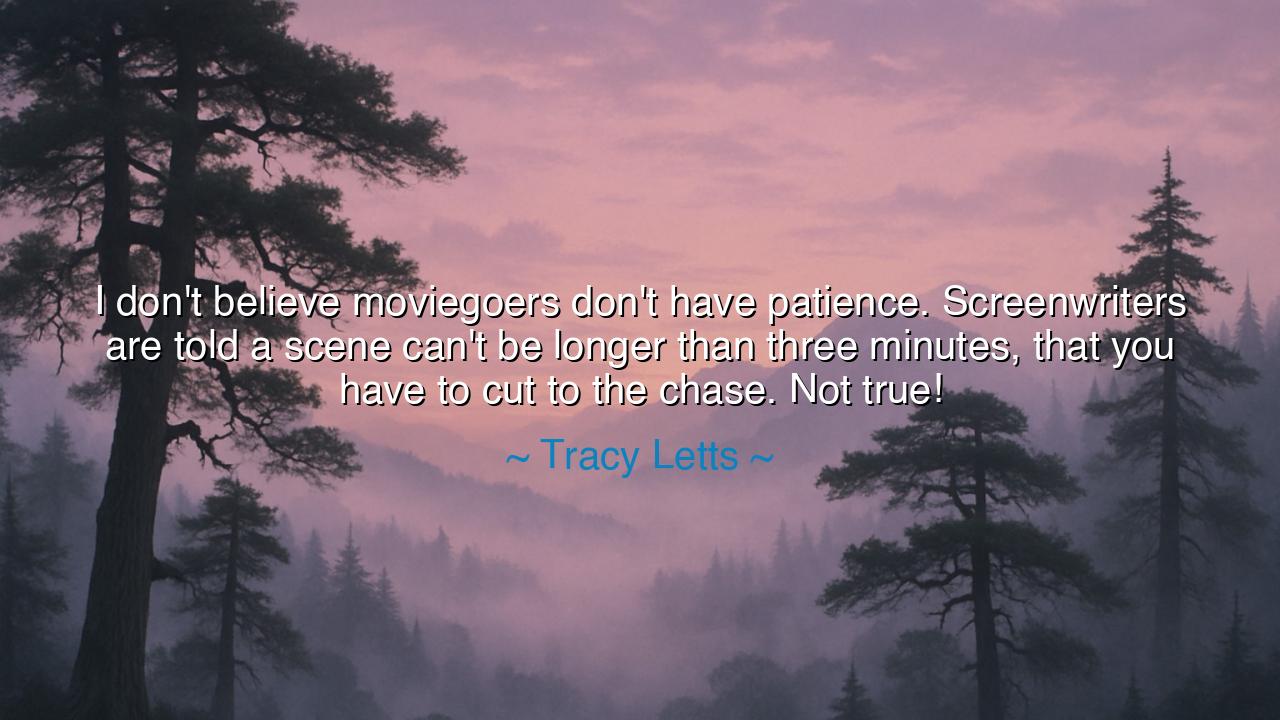
I don't believe moviegoers don't have patience. Screenwriters
I don't believe moviegoers don't have patience. Screenwriters are told a scene can't be longer than three minutes, that you have to cut to the chase. Not true!






Tracy Letts, the playwright and actor, once declared with quiet defiance: “I don't believe moviegoers don't have patience. Screenwriters are told a scene can't be longer than three minutes, that you have to cut to the chase. Not true!” These words strike against a modern assumption—that audiences live only on brevity, speed, and distraction. Instead, he honors the truth that patience is not dead, that human beings still crave depth, rhythm, and immersion in a story.
The origin of this reflection lies in Letts’ work as both a stage writer and a screen actor. On the stage, scenes often stretch in long, rolling dialogue; tension builds not in flashes but in layers. In contrast, Hollywood’s commercial machinery often insists on compression, fearing that the audience will drift if not constantly jolted by movement and conflict. Letts challenges this doctrine. He insists that the soul of storytelling is not in racing toward the end, but in allowing moments to breathe, for it is in the pauses, the silences, the long unfolding of a scene, that truth is revealed.
History itself supports him. Consider the works of Shakespeare, whose soliloquies stretch far longer than three minutes, yet have enthralled audiences for centuries. Hamlet’s brooding “To be, or not to be” does not cut to the chase—it lingers, turning the mind in spirals of thought. And yet it has moved audiences generation after generation, proving that patience in art is rewarded with revelation. So too with film: directors like Andrei Tarkovsky or Satyajit Ray dared to let moments unfold slowly, and in that slowness created cinema that touches eternity.
Letts’ words also stand as a rebuke to fear-driven creativity. Too often, creators underestimate their audiences, assuming that modern souls, dulled by devices and trained by short clips, cannot endure more than a handful of minutes. But to assume this is to insult the human spirit, which has always hungered for story, ritual, and journey. The truth is not that people lack patience—it is that they are rarely given the chance to exercise it in art. Offer them a story worth waiting for, and they will wait.
There is also within his words a call to courage for artists. To let a scene live beyond the prescribed three minutes is an act of defiance, a refusal to bow before the tyranny of formula. It demands faith in one’s story and respect for one’s audience. This courage is what distinguishes an artist from a mere entertainer: the artist risks testing patience in order to awaken wonder, while the entertainer cuts relentlessly, fearing loss of attention. Letts urges us to trust the audience’s hunger for meaning over speed.
The lesson for us is clear: do not mistake speed for strength. In storytelling, in conversation, in life itself, allow space for the long moment, the lingering pause, the unfolding of thought. Trust that those who truly seek will stay with you. The art of patience is not outdated—it is timeless. Just as the reader of an epic, the listener of an elder’s tale, or the viewer of a long, unhurried scene is rewarded, so too are we rewarded in life when we wait with attention.
Practical wisdom follows. When you tell your own stories—whether on page, stage, or screen—do not cut too quickly for fear of losing your listener. Let the truth breathe. In your daily life, resist the tyranny of haste; allow conversations, meals, and quiet moments to stretch. Train yourself and others to rediscover the strength of patience. In this way, you honor not only Tracy Letts’ challenge but the deepest nature of humanity itself.
Thus let these words endure: patience belongs to the human heart as much as curiosity and hunger. Do not starve it with haste. Trust your audience, trust your companions, and trust yourself. For it is in the willingness to linger that we encounter the fullness of truth.






AAdministratorAdministrator
Welcome, honored guests. Please leave a comment, we will respond soon